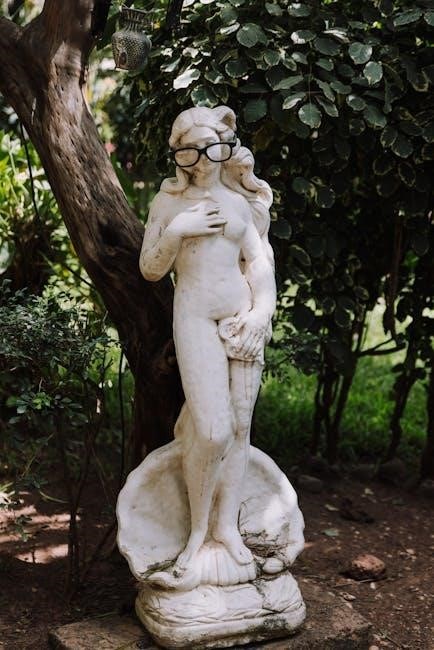Margaret Edson, an American playwright and teacher, gained acclaim with her Pulitzer Prize-winning play Wit, which debuted in 1995․ The play explores academia, mortality, and human connection through Vivian Bearing’s journey with ovarian cancer, blending intellectual rigor with emotional depth․ Its availability in PDF format has made it accessible for global readers, enhancing its impact on contemporary theater․
Background of Margaret Edson
Margaret Edson is an American playwright and teacher, best known for her Pulitzer Prize-winning play Wit․ Before her success in theater, Edson worked as a kindergarten teacher and later as a unit clerk in an oncology/AIDS unit at a research hospital․ Her unique blend of academic and medical experiences deeply influenced her writing, particularly in exploring themes of mortality, academia, and human connection․ Edson’s background in English literature and her observations of patient care shaped the intellectual and emotional depth of her work, making her a distinctive voice in contemporary theater․

The Significance of “Wit” in Contemporary Theater
Wit holds a profound place in contemporary theater for its unique blend of intellectual rigor and emotional depth․ Margaret Edson’s play challenges traditional dramatic structures by intertwining academic discourse with personal vulnerability, creating a narrative that resonates universally․ Its exploration of mortality, identity, and human connection offers a fresh perspective on life’s complexities․ The play’s success, marked by numerous awards, including the Pulitzer Prize, has solidified its influence on modern theater, inspiring new works that balance intellectual and emotional storytelling․ Its enduring relevance continues to captivate audiences and scholars alike․

Plot and Structure of “Wit”
The play follows Vivian Bearing, a professor with terminal cancer, as she reflects on her life and academic career through a non-linear narrative interspersed with John Donne’s poetry, blending intellectual analysis with emotional vulnerability․
The Protagonist: Vivian Bearing
Vivian Bearing, a renowned professor of English literature, is diagnosed with terminal ovarian cancer․ Her intellectual brilliance, rooted in her mastery of John Donne’s poetry, contrasts with her emotional vulnerability․ Throughout the play, Vivian’s sharp wit and academic rigor are juxtaposed with her isolation and existential reckoning․ Her journey from detachment to introspection reveals a complex character grappling with mortality, highlighting the limitations of intellect in the face of death․ Vivian’s transformation underscores the play’s exploration of human connection and the search for meaning beyond academic pursuits․
The Non-Linear Narrative and Its Impact
The play’s non-linear narrative unfolds through Vivian Bearing’s fragmented memories, reflecting her scholarly mindset and emotional journey․ Flashbacks interweave her academic achievements with her cancer treatment, creating a juxtaposition of intellect and vulnerability․ This structure mirrors the complexity of John Donne’s poetry, which Vivian studies, emphasizing themes of life, death, and divine love․ The non-linear format heightens the emotional depth, allowing audiences to witness Vivian’s transformation from detachment to introspection․ By blending past and present, the narrative underscores the tension between intellectual rigor and human connection, ultimately revealing the limits of academic pursuits in the face of mortality․

Themes Explored in “Wit”
Wit delves into academia, mortality, and human connection, contrasting intellectual rigor with emotional vulnerability․ The play explores life’s meaning, highlighting the limits of academic pursuits and the need for empathy, resonating deeply with readers in its PDF form․
The Intersection of Academia and Mortality
In Wit, Margaret Edson masterfully explores the intersection of academia and mortality through Vivian Bearing’s journey․ A renowned professor of English, Vivian’s intellectual rigor in analyzing John Donne’s poetry contrasts sharply with her confrontation of terminal cancer․ The play highlights how academic pursuits, while intellectually fulfilling, often fail to prepare individuals for life’s existential questions․ Vivian’s clinical treatment serves as a backdrop for her emotional and philosophical reckoning, illustrating the limits of intellectual control in the face of death․ This duality underscores the play’s profound exploration of life’s meaning and the balance between intellect and human vulnerability․
Intellectual Rigor vs․ Emotional Vulnerability
Vivian Bearing’s journey in Wit starkly contrasts her intellectual brilliance with her emotional vulnerability․ As a professor of English, her life revolves around the meticulous analysis of John Donne’s poetry, showcasing her academic prowess․ However, her diagnosis with terminal cancer forces her to confront the emotional void left by her single-minded pursuit of knowledge․ The play highlights how intellectual rigor, while defining her career, leaves her unprepared for the raw emotions of mortality․ This tension between mind and heart underscores the limitations of academia in addressing life’s profound emotional and existential questions, revealing a deeply human struggle beneath her scholarly facade․
The Search for Human Connection
Vivian Bearing’s journey in Wit reveals a profound longing for human connection amidst her academic achievements and terminal illness․ Despite her intellectual brilliance, her life is marked by isolation, with few genuine relationships․ The play contrasts her emotional distance from colleagues with moments of kindness from her nurse, Susie, and a former student, highlighting the tension between intellectual pursuits and the human need for empathy․ This search for connection underscores the plays exploration of lifes meaning, emphasizing that true fulfillment lies not in scholarly accomplishments but in the bonds we form with others․ The PDF version of Wit captures this poignant theme, resonating deeply with readers․
The Title “Wit” and Its Dual Significance
The title Wit reflects both intellectual brilliance and emotional depth, capturing Vivian Bearing’s academic prowess and her vulnerable confrontation with mortality and human connection․
Intellectual Brilliance and Emotional Depth
Margaret Edson’s Wit masterfully juxtaposes Vivian Bearing’s intellectual brilliance with her emotional vulnerability․ As a renowned scholar of John Donne’s poetry, Vivian’s sharp mind contrasts with her poignant struggle against terminal cancer․ Her academic rigor, once her defining trait, is mirrored by the emotional depth she uncovers during her illness․ The play highlights how intellect, though powerful, cannot fully confront mortality, revealing the limits of reasoning in the face of death․ This duality underscores the human need for connection beyond mere intellect, making Wit a profound exploration of life, death, and the true meaning of wit․
The Play’s Tone and Thematic Reflection

The tone of Wit shifts seamlessly between clinical detachment and poignant introspection, mirroring Vivian Bearing’s dual identity as a scholar and a patient․ The play’s thematic reflection lies in its exploration of mortality, academia, and human connection, with Vivian’s journey serving as a metaphor for the search for meaning in life’s final stages․ The title Wit itself encapsulates this duality, reflecting both intellectual brilliance and emotional vulnerability․ Through its balance of humor and pathos, the play underscores the limitations of intellectual pursuits in confronting death, ultimately emphasizing the profound importance of human empathy and connection․
The Role of John Donne’s Poetry
John Donne’s poetry is central to Wit, reflecting Vivian Bearing’s academic passion and existential struggle, serving as a metaphor for her journey through cancer and mortality․

Metaphysical Poetry and Its Relevance
John Donne’s metaphysical poetry, known for its intellectual complexity and emotional depth, plays a pivotal role in Wit․ His works, particularly the Holy Sonnets, explore themes of life, death, and divine love, mirroring Vivian Bearing’s existential journey․ The poetry’s intricate structures and imagery serve as a metaphor for Vivian’s structured yet emotionally charged struggle with cancer․ Donne’s wit, characterized by intellectual ingenuity and surprise, reflects Vivian’s academic brilliance and her efforts to confront mortality․ The interplay between Donne’s poetry and Vivian’s narrative underscores the tension between intellectual rigor and emotional vulnerability, enriching the play’s exploration of academia, mortality, and human connection․
Donne’s Sonnets as a Mirror to Vivian’s Journey
John Donne’s Holy Sonnets serve as a profound metaphor for Vivian Bearing’s journey in Wit․ The sonnets’ themes of life, death, and divine love parallel Vivian’s confrontation with mortality, blending intellectual rigor with emotional vulnerability․ Donne’s intricate structures and imagery mirror Vivian’s structured yet deeply personal struggle with cancer․ The sonnets’ exploration of spirituality and existential reckoning align with Vivian’s own introspection, highlighting the tension between academic detachment and human connection․ Through Donne’s poetry, Edson underscores the limits of intellectual pursuits in the face of death, revealing the universal search for meaning and transcendence․
The Play’s Use of Metaphor and Symbolism
The play employs metaphor and symbolism, contrasting the clinical hospital environment with Vivian’s emotional journey, reflecting the tension between intellectual rigor and human vulnerability․
The Clinical Environment vs․ Emotional Landscape
The clinical environment in Wit symbolizes detachment and control, contrasting with Vivian’s emotional vulnerability․ The hospital’s sterile, impersonal setting mirrors her academic rigor, while her cancer diagnosis and treatment expose her inner fragility․ The play uses the clinical space to highlight the tension between intellectual precision and human empathy; Vivian’s emotional journey, marked by isolation and reflection, underscores the limitations of intellect in confronting mortality․ The clinical environment serves as a metaphor for the emotional numbness of modern medicine, while Vivian’s struggles humanize the sterile backdrop, emphasizing the need for connection in the face of death․
The Symbolism of the Hospital Setting
The hospital in Wit serves as a potent symbol of both control and isolation․ Its sterile, impersonal environment mirrors Vivian’s emotional detachment and academic rigor․ The clinical setting, with its focus on treatment protocols and medical precision, underscores the tension between intellectual control and the uncontrollable nature of cancer․ The hospital’s cold, technological backdrop contrasts with Vivian’s growing vulnerability, highlighting the limits of modern medicine in addressing the human spirit․ Yet, amidst this clinical order, moments of kindness from her nurse, Susie, pierce the emotional numbness, reminding Vivian—and the audience—of the enduring importance of human connection in the face of mortality․

Critical Reception and Awards
Wit won the 1999 Pulitzer Prize for Drama and other prestigious awards, and was adapted into an Emmy-winning film, highlighting its significant influence on theater and cinema․

The Pulitzer Prize for Drama
Wit earned the prestigious 1999 Pulitzer Prize for Drama, recognizing its profound exploration of mortality, academia, and human connection․ This accolade solidified its place in theatrical history, celebrating Margaret Edson’s ability to weave complex themes into a deeply moving narrative․ The play’s intellectual depth and emotional resonance resonated with critics and audiences alike, making it a standout work․ Its Pulitzer win marked a milestone, highlighting Edson’s unique voice and her ability to balance intellectual rigor with emotional vulnerability, leaving a lasting impact on contemporary theater․
Audience and Critical Acclaim
Wit has garnered widespread critical acclaim and audience admiration for its poignant portrayal of life, death, and intellectual pursuits․ Critics praise its emotional depth, sharp wit, and nuanced exploration of humanity․ Audiences connect deeply with Vivian Bearing’s journey, finding solace in her resilience and vulnerability․ The play’s ability to balance humor with heartbreak has made it a favorite, earning praise for its originality and universal themes․ Its faithful adaptation to screen, starring Emma Thompson, further cemented its cultural impact and audience appreciation, solidifying its place as a modern theatrical masterpiece․

The Availability of “Wit” in PDF Format
Wit by Margaret Edson is widely available in PDF format through various online platforms, academic databases, and educational websites, offering easy access for global readers and scholars alike․
Sources for Downloading the PDF
The PDF version of Margaret Edson’s Wit is accessible through various platforms, including Google Books, Amazon, and Scribd․ Academic databases and university libraries also offer free or paid access․ Additionally, educational websites and online archives provide convenient download options․ Readers can easily locate the play through these reliable sources, ensuring widespread availability for both academic and personal reading purposes․ This accessibility has made Wit a preferred choice for students, scholars, and theater enthusiasts worldwide․
The Convenience of Digital Access
The digital format of Margaret Edson’s Wit offers unparalleled convenience, allowing readers to access the play on various devices such as tablets, e-readers, and smartphones․ This accessibility enables seamless reading and annotation, enhancing engagement with the text․ The PDF version is easily downloadable, making it a preferred choice for students, scholars, and theater enthusiasts․ Digital access also facilitates quick searches and reference checks, fostering a deeper understanding of the play’s themes and literary brilliance․ This convenience has broadened the play’s reach, ensuring its profound exploration of life, death, and intellect remains accessible to a global audience․

The Play’s Emotional and Intellectual Depth
Wit masterfully intertwines Vivian Bearing’s intellectual brilliance with her poignant emotional journey, offering profound insights into life, death, and human connection through its layered narrative․
Vivian’s Transformation and Growth
Vivian Bearing’s journey in Wit is a profound transformation from a detached academic to a reflective individual confronting mortality․ Diagnosed with terminal ovarian cancer, she initially approaches her illness with intellectual rigor, analyzing it like a Donne sonnet; However, as the play progresses, her emotional vulnerability surfaces, revealing a deep longing for human connection․ Through her interactions with her nurse, Susie, and flashbacks to her academic career, Vivian realizes the limitations of intellect in the face of death․ Her growth lies in embracing empathy and understanding the value of personal relationships, ultimately finding meaning beyond academic pursuits․
The Balance of Humor and Pathos
Wit masterfully balances humor and pathos, creating a nuanced exploration of life and death․ Vivian Bearings sharp wit and sarcasm provide moments of dark humor, contrasting with the poignant reality of her terminal cancer․ Her intellectual rigor and clever wordplay mask her vulnerability, while her emotional struggles evoke deep empathy․ This duality makes the play both intellectually stimulating and emotionally resonant; The interplay of humor and pathos highlights the complexity of Vivians character, showcasing her resilience and humanity․ This balance ensures the play is both thought-provoking and deeply moving, leaving a lasting impact on audiences․
The Exploration of Life and Death
Wit profoundly explores life and death through Vivian Bearings journey with cancer, blending intellectual rigor with emotional vulnerability․ John Donnes poetry mirrors her existential struggle, highlighting the human condition․
The Limits of Intellectual Pursuits
In Wit, Margaret Edson examines the boundaries of intellectualism through Vivian Bearings journey․ A renowned scholar of John Donnes poetry, Vivian finds her academic brilliance insufficient to navigate mortality․ Her rigorous analytical mind, once her defining trait, struggles to confront the emotional and existential dimensions of death․ The play reveals how intellectual pursuits, while profound, cannot fully address the human experience of suffering and vulnerability․ This duality underscores the limitations of intellect in the face of life’s ultimate questions, emphasizing the need for empathy and connection beyond academic achievement․
The Importance of Human Empathy
In Wit, Margaret Edson underscores the vital role of human empathy in a world often dominated by intellectual pursuits․ Vivian Bearings journey through terminal cancer reveals her emotional vulnerability, contrasting with her academic detachment․ The clinical environment, focused on treatment and data, highlights the stark absence of empathy in her care․ Yet, moments of kindness from her nurse, Susie, and a former student offer solace, emphasizing the necessity of human connection․ The play illustrates how empathy transcends intellectual rigor, providing comfort and meaning in the face of mortality, ultimately revealing the profound importance of compassion in human experience․
The Impact of “Wit” on Modern Theater
Wit has left a lasting legacy in modern theater, earning the Pulitzer Prize and inspiring adaptations․ Its fresh perspective on mortality and human connection continues to resonate deeply․
A Fresh Perspective on Mortality
Margaret Edson’s Wit offers a fresh perspective on mortality by blending intellectual rigor with emotional vulnerability․ The play explores death through Vivian Bearing’s cancer journey, contrasting clinical detachment with profound introspection․ Edson’s unique voice, shaped by her experiences as a teacher and hospital worker, infuses the narrative with both compassion and analytical precision․ By weaving metaphysical poetry into the storyline, Wit examines life’s meaning beyond academic pursuits, revealing the limits of intellect in the face of death․ This duality underscores the play’s exploration of isolation, human connection, and the search for meaning in life’s final stages․
The Play’s Lasting Legacy
Margaret Edson’s Wit has left an indelible mark on modern theater, celebrated for its profound exploration of mortality, academia, and human connection․ Winning the Pulitzer Prize in 1999, it solidified its place as a contemporary classic․ The play’s adaptation into an Emmy-winning film further expanded its reach, introducing its themes to a broader audience․ Its availability in PDF format has ensured its accessibility for academic study and personal reflection․ Wit continues to resonate, offering a fresh perspective on life’s complexities and inspiring new generations of theater enthusiasts and scholars with its emotional and intellectual depth․
Margaret Edson’s Wit remains a profound exploration of mortality, academia, and human connection, leaving a lasting impact on theater and readers through its emotional and intellectual brilliance․
The Enduring Relevance of “Wit”
Margaret Edson’s Wit continues to resonate deeply, offering a poignant exploration of mortality, academia, and human connection․ Its emotional and intellectual depth ensures its relevance in contemporary theater and literature․ The play’s universal themes, such as the limits of intellectual pursuits and the importance of empathy, remain timely and thought-provoking․ Available in PDF format, Wit reaches a global audience, inspiring reflection on life’s profound questions․ Its enduring appeal lies in its ability to balance humor with pathos, creating a powerful narrative that lingers long after the final page․
Final Thoughts on the Play’s Significance
Margaret Edson’s Wit remains a profound exploration of life, death, and human connection, resonating deeply with audiences and scholars alike․ Its Pulitzer Prize-winning brilliance lies in its ability to weave intellectual rigor with emotional vulnerability, creating a narrative that transcends time․ The play’s themes of mortality, academia, and empathy continue to provoke thought, while its availability in PDF format ensures its accessibility for future generations․ Wit stands as a testament to the power of theater to confront life’s most universal questions, leaving a lasting legacy in contemporary literature and drama․